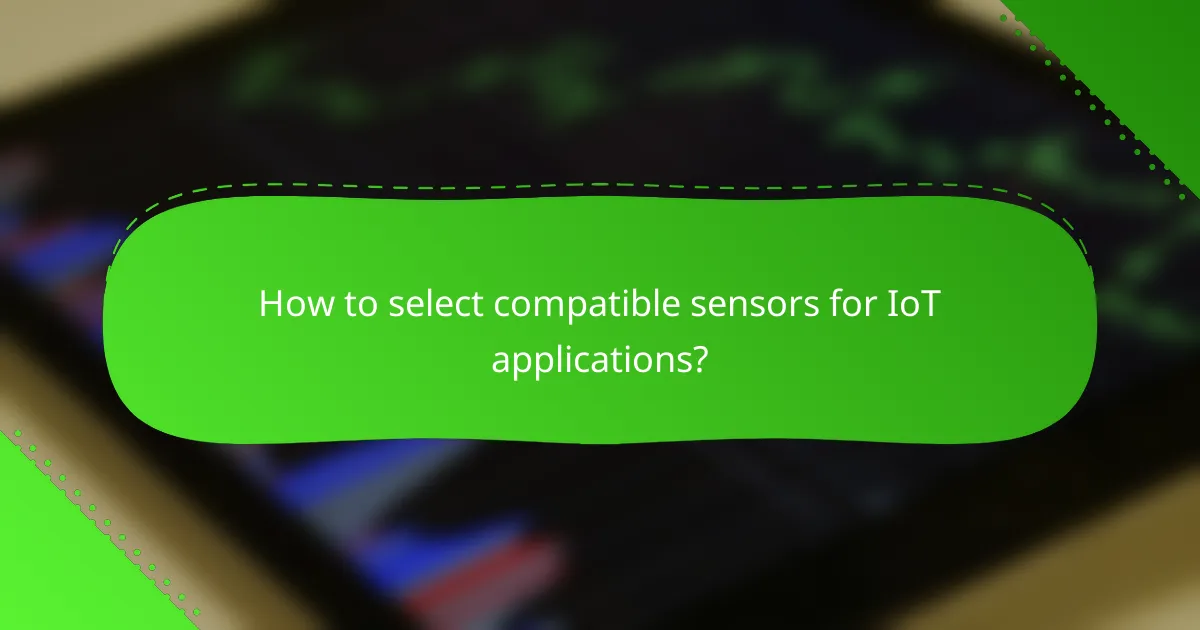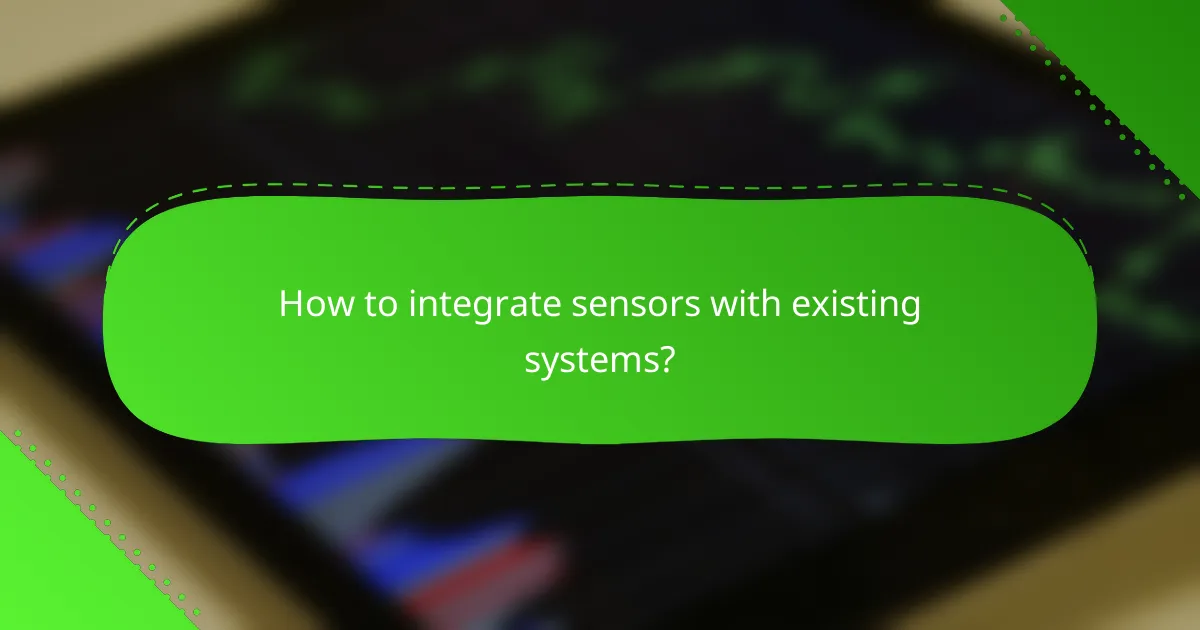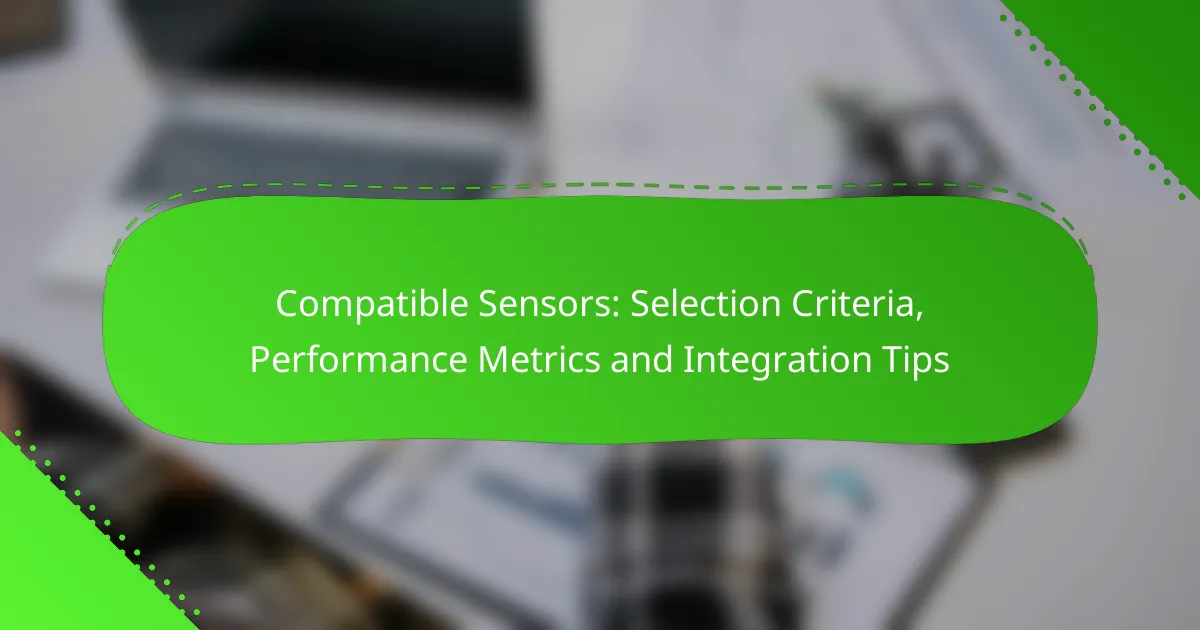Choosing compatible sensors for smart home and IoT systems is crucial for achieving optimal performance and seamless integration. Important selection criteria include compatibility with existing platforms, key performance metrics such as accuracy and response time, and the specific requirements of your project. By carefully evaluating these factors, you can enhance automation, security, and overall system reliability.

What are the best compatible sensors for smart home systems?
The best compatible sensors for smart home systems include devices that seamlessly integrate with various platforms, enhancing automation and security. Key considerations include compatibility with existing systems, performance metrics like response time, and ease of installation.
Philips Hue Motion Sensor
The Philips Hue Motion Sensor is designed for use with the Hue lighting ecosystem, providing automated lighting based on movement detection. It features a wide detection range and can be easily mounted indoors or outdoors.
When selecting this sensor, consider its sensitivity settings and the ability to adjust light brightness and color based on time of day. It’s ideal for creating a welcoming atmosphere in hallways or entryways.
Ecobee SmartSensor
The Ecobee SmartSensor works in conjunction with Ecobee thermostats to optimize heating and cooling based on occupancy. It detects motion and can also measure temperature, allowing for more efficient climate control.
For best results, place the sensor in rooms where you spend the most time. This sensor can help reduce energy costs by ensuring that heating or cooling only occurs when needed.
Samsung SmartThings Motion Sensor
The Samsung SmartThings Motion Sensor integrates with the SmartThings ecosystem, enabling automation of various smart devices. It can trigger actions like turning on lights or sending alerts when motion is detected.
Ensure compatibility with your existing SmartThings devices for seamless integration. This sensor is particularly useful for enhancing security by monitoring entry points in your home.
Ring Indoor Cam
The Ring Indoor Cam offers video surveillance capabilities along with motion detection, allowing you to monitor your home remotely. It features two-way audio and night vision, making it versatile for indoor security.
When using this camera, consider the placement for optimal coverage and ensure your Wi-Fi signal is strong. The device can be integrated with other Ring products for a comprehensive security system.
Wyze Cam v3
The Wyze Cam v3 is an affordable indoor/outdoor camera that provides 1080p video quality and color night vision. It includes motion detection features and can be integrated with other Wyze devices for a smart home setup.
For effective use, position the camera in areas where you want to monitor activity. The Wyze app allows for easy access to live feeds and alerts, making it a practical choice for budget-conscious users.

How to select compatible sensors for IoT applications?
Selecting compatible sensors for IoT applications involves understanding the specific requirements of your project, including communication methods, power needs, and environmental conditions. A well-chosen sensor can enhance data accuracy and system reliability while ensuring seamless integration into your IoT framework.
Evaluate communication protocols
When evaluating communication protocols, consider the compatibility of the sensor with your existing network infrastructure. Common protocols include Wi-Fi, Bluetooth, Zigbee, and LoRaWAN, each with its own strengths and weaknesses in terms of range, bandwidth, and power consumption.
For instance, Wi-Fi offers high data rates but consumes more power, making it suitable for devices with a stable power supply. In contrast, LoRaWAN is ideal for long-range applications with low power requirements, often used in remote monitoring scenarios.
Assess power consumption
Power consumption is a critical factor in sensor selection, especially for battery-operated devices. Look for sensors that offer low power modes or sleep modes to extend battery life, which can range from several months to years depending on usage.
For example, a sensor with a power consumption of less than 10 mA during active operation and microamps in sleep mode can be ideal for applications where battery replacement is challenging. Always calculate the total energy requirements based on expected data transmission frequency and operational duration.
Check environmental compatibility
Environmental compatibility ensures that sensors can operate effectively under specific conditions such as temperature, humidity, and exposure to dust or water. Sensors should be rated for the conditions they will face, with common ratings including IP65 for water and dust resistance.
For instance, if deploying sensors outdoors, consider those with a wide temperature range and robust housing to withstand harsh weather. Always verify that the materials used in the sensor are suitable for the intended environment to prevent degradation over time.

What performance metrics should be considered?
When selecting compatible sensors, key performance metrics include accuracy, response time, range, and battery life. These factors significantly influence the sensor’s effectiveness and suitability for specific applications.
Accuracy and precision
Accuracy refers to how close a sensor’s readings are to the true value, while precision indicates the consistency of those readings. For most applications, a sensor should have an accuracy within a few percentage points of the actual measurement to be reliable.
Consider the specific requirements of your project. For example, environmental sensors may require an accuracy of ±1°C for temperature readings, while industrial applications might demand tighter tolerances. Always check the manufacturer’s specifications for these metrics.
Response time
Response time is the duration it takes for a sensor to detect a change and provide a reading. This metric is crucial in applications where real-time data is essential, such as in safety systems or automated processes.
Typical response times can range from low tens of milliseconds for high-performance sensors to several seconds for others. When evaluating sensors, prioritize those with faster response times to ensure timely data collection and action.
Range and coverage
Range refers to the operational limits of a sensor, while coverage indicates the area it can effectively monitor. Selecting a sensor with appropriate range and coverage is vital for ensuring it meets the needs of your specific application.
For instance, a temperature sensor might have a range of -40°C to 125°C, while a motion sensor may cover a radius of up to 30 meters. Assess the environmental conditions and spatial requirements to choose a sensor that fits your needs.
Battery life
Battery life is a critical factor for sensors that operate in remote or hard-to-reach locations. Longer battery life reduces maintenance needs and downtime, making it essential for continuous monitoring applications.
Typical battery life can vary widely, from a few months to several years, depending on the sensor’s power consumption and usage patterns. Look for sensors with energy-efficient designs and consider options like solar power for extended deployments.

How to integrate sensors with existing systems?
Integrating sensors with existing systems involves connecting the sensors to your current infrastructure to ensure seamless data flow and functionality. Key considerations include compatibility, data formats, and communication protocols.
Use API documentation
API documentation is crucial for understanding how to connect sensors to your systems. It provides detailed information on endpoints, data structures, and authentication methods. Always refer to the manufacturer’s API documentation to ensure proper integration.
When reviewing API documentation, look for examples of requests and responses. This will help you visualize how data will be exchanged and identify any potential issues before implementation.
Implement middleware solutions
Middleware solutions act as intermediaries between sensors and existing systems, facilitating communication and data management. They can help translate data formats and protocols, making integration smoother.
Consider using middleware platforms that support multiple protocols and data types. This flexibility can save time and reduce the complexity of integrating various sensors into your system.
Follow best practices for data security
Data security is paramount when integrating sensors, as they often handle sensitive information. Implement encryption for data in transit and at rest to protect against unauthorized access.
Regularly update your systems and sensors to patch vulnerabilities. Additionally, establish strict access controls to limit who can interact with the sensor data and integration points.

What are common challenges in sensor integration?
Common challenges in sensor integration include compatibility issues and data latency. These factors can significantly impact the performance and reliability of sensor systems, making it essential to address them during the integration process.
Compatibility issues
Compatibility issues arise when sensors do not align with the existing hardware or software systems. This can include mismatched communication protocols, voltage levels, or physical connectors. Ensuring that sensors are compatible with the intended platform is crucial for seamless integration.
To mitigate compatibility problems, conduct thorough research on sensor specifications and system requirements before selection. Utilize standardized protocols like I2C or SPI when possible, as they promote interoperability among various devices. Testing sensors in a controlled environment can also help identify potential issues early on.
Data latency
Data latency refers to the delay between data generation by a sensor and its availability for processing. High latency can hinder real-time applications, such as autonomous vehicles or industrial automation, where timely data is critical. Understanding the acceptable latency levels for your application is vital.
To minimize data latency, select sensors with fast response times and optimize data transmission methods. For instance, using wired connections generally results in lower latency compared to wireless options. Regularly monitor and analyze data flow to ensure that latency remains within acceptable limits for your specific use case.
